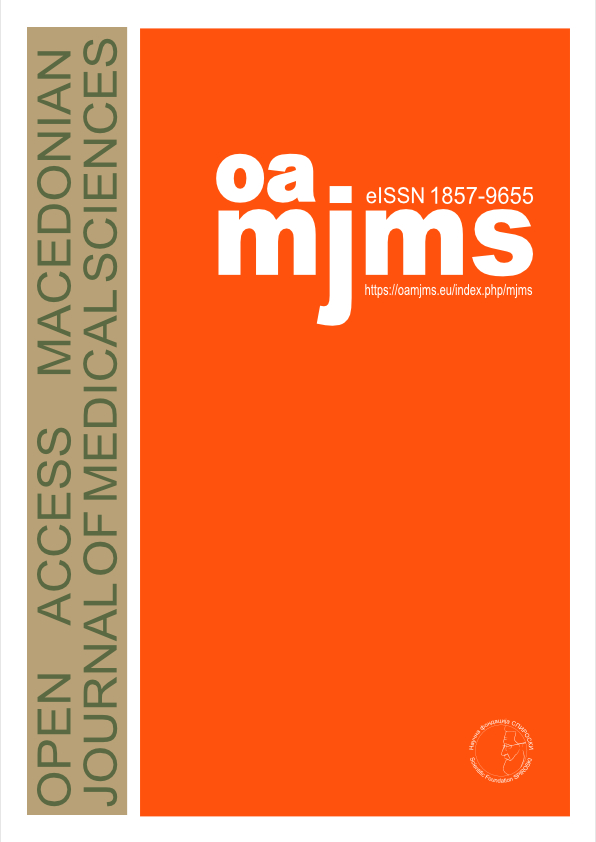Assessing the Current Healthcare System Capacity in Kosovo to Address Potential Risks of Climate Change Extremes
DOI:
https://doi.org/10.3889/oamjms.2024.11951Keywords:
Climate Change, Kosovo, Risk assessment, Hospital disaster preparedness, Vulnerability and adaptation assessmentAbstract
BACKGROUND: Climate change (CC) threats to public health in Kosovo include changes in rainfall and extreme weather conditions (heat waves, rising average temperatures, floods, and droughts). Such changes can affect the physical, mental health, and well-being of the population, also potentially adversely affecting the functioning and physical infrastructure of the healthcare system.
AIM: The aim of the study was to conduct a CC vulnerability assessment in selected healthcare facilities and workforce in Kosovo.
METHODS: The World Health Organization standard checklist was used to assess weaknesses and level of preparedness in six healthcare facilities in the context of CC for three extreme situations of exposure (heat waves, floods, and droughts).
RESULTS: During heat waves and floods the weak points identified are: The infrastructure, technology process, healthcare workforce preparedness, and process of waste treatment. In some regions (Mitrovica and Peja), the risk is even higher in the absence of sufficient health staff. The hospital in Gjilan shows the highest level of unpreparedness to cope some CC extremes. The western part of the country has a higher risk of frequent floods. The lack of an emergency plan to protect health workers from numerous biological and chemical risks increases the risk of negative effects of floods.
CONCLUSIONS: The findings of this study confirm various types of vulnerabilities and weaknesses in the healthcare facilities in Kosovo for all areas of assessment (health workforce preparedness, level of adaptation of the current system, infrastructure, technologies, and sustainability). The health outcomes of CC jeopardize the provision of good quality healthcare services. A short list of priorities is recommended to minimize the various types of vulnerabilities.
Downloads
Metrics
Plum Analytics Artifact Widget Block
References
World Health Organization (WHO). Climate Change. Available from: https://www.who.int/health-topics/climate-change#tab=tab_1 [Last accessed on 2024 May 15].
World Health Organization. Checklists to Assess Vulnerabilities in Healthcare Facilities in the Context of Climate Change. Geneva: World Health Organization; 2021.
Intergovernmental Panel on Climate Change (IPCC). Long- term Climate Change: Projections, Commitments and Irreversibility. Available from: https://www.ipcc.ch/site/assets/uploads/2018/02/wg1ar5_chapter12_final.pdf [Last accessed on 2024 May 15].
Environmental Protection Agency (EPA). Understanding the Connections between Climate Change and Human Health. Available from: https://www.epa.gov/climate-indicators/understanding-connections-between-climate-change-and- human-health [Last accessed on 2024 May 16].
Agache I, Sampath V, Aguilera J, Akdis CA, Akdis M, Barry M, et al. Climate change and global health: A call to more research and more action. Allergy. 2022;77(5):1389-407. https://doi.org/10.1111/all.15229 PMid:35073410 DOI: https://doi.org/10.1111/all.15229
The Commonwealth Fund. Improving Health Care Quality. Available from: https://www.commonwealthfund.org/publications/explainer/2022/may/impact-climate-change-our- health-and-health-systems [Last accessed on 2024 May 20].
World Health Organization (WHO). WHO Regional Office for Africa, 2015. Operational Framework for Building Climate Resilient Health Systems. Available from: https://www.afro.who.int/publications/operational-framework-building-climate- resilient-health-systems [Last accessed on 2024 May 20].
World Health Organization (WHO). Climate Change and Health Vulnerability and Adaptation Assessment; 2021. Available from: https://apps.who.int/iris/bitstream/handle/10665/345968/ 9789240036383eng.pdf?sequence=1&isAllowed=y [Last accessed on 2024 May 21].
World Health Organization (WHO). Guidance for Climate- resilient and Environmentally Sustainable Health Care Facilities; 2020. Available from: https://www.who.int/publications/i/item/9789240012226 [Last accessed on 2024 May 15].
World Bank. Diagnostic Report Emergency Preparedness and Response Assessment Kosovo; 2021. Available from: https://documents1.worldbank.org/curated/en/959001621917488766/pdf/kosovo-ready-2-respond-emergency-preparedness-and- response-assessment-diagnostic-report.pdf [Last accessed on 2024 Jul 27].
EUROSTAT. Enlargement Countries - Population Statistics. Available from: https://ec.europa.eu/eurostat/statistics- explained/index.php?title=enlargement_countries_-_population_statistics [Last accessed on 2024 Jun 16].
EUROSTAT. Demography of Europe - 2024 edition. Available from: https://ec.europa.eu/eurostat/web/interactive-publications/ demography-2024 [Last accessed on 2024 Jun 16].
World Bank. Diagnostic Report Emergency Preparedness and Response Assessment North Macedonia; 2021. Available from: https://documents1.worldbank.org/curated/en/340711620280963213/pdf/north-macedonia-emergency-preparedness-and-response-assessment-diagnostic-report.pdf [Last accessed on 2024 Jul 28].
Radovic V, Vitale K, Tchounwou PB. Health facilities safety in natural disasters: Experiences and challenges from South East Europe. Int J Environ Res Public Health. 2012;9(5):1677-86. https://doi.org/10.3390/ijerph9051677 PMid:22754465 DOI: https://doi.org/10.3390/ijerph9051677
World Health Organization (WHO). Emergencies. Health Workforce. Available from: https://www.who.int/europe/ emergencies/our-work-in-emergencies/health-systems-for-emergencies/health-workforce [Last accessed on 2024 Jun 21].
Khirekar J, Badge A, Bandre GR, Shahu S. Disaster preparedness in hospitals. Cureus. 2023;15(12):e50073. https://doi.org/10.7759/cureus.50073 PMid:38192940 DOI: https://doi.org/10.7759/cureus.50073
Lotta G, Nunes J, Fernandez M, Correa MG. The impact of the COVID-19 pandemic in the frontline health workforce: Perceptions of the vulnerability of Brazil’s community health workers. Health Policy Open. 2022;3:100065. https://doi.org/10.1016/j.hpopen.2021.100065 PMid:35036911 DOI: https://doi.org/10.1016/j.hpopen.2021.100065
Lotta G. Fernandez M, Correa M. The vulnerabilities of the Brazilian health workforce during health emergencies: Analyzing personal feelings, access to resources and work dynamics during the COVID-19 pandemic. Int J Health Plann Manage. 2021;36(S1):42-57. https://doi.org/10.1002/hpm.3117 PMid:33502795 DOI: https://doi.org/10.1002/hpm.3117
Guihenneuc J,Ayraud-Thevenot S, Roschnik S, DupuisA, Migeot V. Climate change and health care facilities: A risk analysis framework through a mapping review. Environ Res. 2023;216(Pt 3):114709. https://doi.org/10.1016/j.envres.2022.114709 PMid:36343709 DOI: https://doi.org/10.1016/j.envres.2022.114709
World Health Organization (WHO). Health Emergency and Disaster Risk Management Water, Sanitation and Hygiene. Health Emergency and Disaster Risk Management Fact Sheets; 2017. Available from: https://www.who.int/publications/m/item/health-emergency-and-disaster-risk-management-(edrm)-fact- sheets [Last accessed on 2024 Jul 20].
European Union (EU). Directive 2020/2184 of the European Parliament and of the Council of 16 December 2020 on the Quality of Water Intended for Human Consumption (Recast). Available from: https://eur-lex.europa.eu/eli/dir/2020/2184/oj [Last accessed on 2024 Jun 21].
Rentschler, J, Klaiber, C, Tariverdi, M, Desjonquères, C, Mercadante, J. Frontline: Preparing Healthcare Systems for Shocks, from Disasters to Pandemics. Washington, DC: The World Bank; 2021. Available from: https://documents1.worldbank.org/curated/en/932971618251523386/pdf/frontline-preparing-healthcare-systems-for-shocks-from-disasters-to-pandemics.pdf [Last accessed on 2024 Jul 27]. DOI: https://doi.org/10.1596/35429
Downloads
Published
How to Cite
Issue
Section
Categories
License
Copyright (c) 2024 Lendita Mehmeti Cakuli , Mirjana Dimovska, Dragan Gjorgjev (Author)

This work is licensed under a Creative Commons Attribution-NonCommercial 4.0 International License.
http://creativecommons.org/licenses/by-nc/4.0







